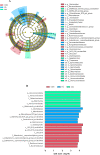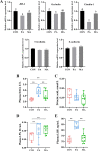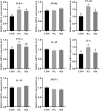Effects of altering the ratio of C16:0 and cis-9 C18:1 in rumen bypass fat on growth performance, lipid metabolism, intestinal barrier, cecal microbiota, and inflammation in fattening bulls
- PMID: 38971799
- PMCID: PMC11227724
- DOI: 10.1186/s40104-024-01052-1
Effects of altering the ratio of C16:0 and cis-9 C18:1 in rumen bypass fat on growth performance, lipid metabolism, intestinal barrier, cecal microbiota, and inflammation in fattening bulls
Abstract
Background: C16:0 and cis-9 C18:1 may have different effects on animal growth and health due to unique metabolism in vivo. This study was investigated to explore the different effects of altering the ratio of C16:0 and cis-9 C18:1 in fat supplements on growth performance, lipid metabolism, intestinal barrier, cecal microbiota, and inflammation in fattening bulls. Thirty finishing Angus bulls (626 ± 69 kg, 21 ± 0.5 months) were divided into 3 treatments according to the randomized block design: (1) control diet without additional fat (CON), (2) CON + 2.5% palmitic acid calcium salt (PA, 90% C16:0), and (3) CON + 2.5% mixed fatty acid calcium salt (MA, 60% C16:0 + 30% cis-9 C18:1). The experiment lasted for 104 d, after which all the bulls were slaughtered and sampled for analysis.
Results: MA tended to reduce 0-52 d dry matter intake compared to PA (DMI, P = 0.052). Compared with CON and MA, PA significantly increased 0-52 d average daily gain (ADG, P = 0.027). PA tended to improve the 0-52 d feed conversion rate compared with CON (FCR, P = 0.088). Both PA and MA had no significant effect on 52-104 days of DMI, ADG and FCR (P > 0.05). PA tended to improve plasma triglycerides compared with MA (P = 0.077), significantly increased plasma cholesterol (P = 0.002) and tended to improve subcutaneous adipose weight (P = 0.066) when compared with CON and MA. Both PA and MA increased visceral adipose weight compared with CON (P = 0.021). Only PA increased the colonization of Rikenellaceae, Ruminococcus and Proteobacteria in the cecum, and MA increased Akkermansia abundance (P < 0.05). Compared with CON, both PA and MA down-regulated the mRNA expression of Claudin-1 in the jejunum (P < 0.001), increased plasma diamine oxidase (DAO, P < 0.001) and lipopolysaccharide (LPS, P = 0.045). Compared with CON and MA, PA down-regulated the ZO-1 in the jejunum (P < 0.001) and increased plasma LPS-binding protein (LBP, P < 0.001). Compared with CON, only PA down-regulated the Occludin in the jejunum (P = 0.013). Compared with CON, PA and MA significantly up-regulated the expression of TLR-4 and NF-κB in the visceral adipose (P < 0.001) and increased plasma IL-6 (P < 0.001). Compared with CON, only PA up-regulated the TNF-α in the visceral adipose (P = 0.01). Compared with CON and MA, PA up-regulated IL-6 in the visceral adipose (P < 0.001), increased plasma TNF-α (P < 0.001), and reduced the IgG content in plasma (P = 0.035). Compared with CON, PA and MA increased C16:0 in subcutaneous fat and longissimus dorsi muscle (P < 0.05), while more C16:0 was also deposited by extension and desaturation into C18:0 and cis-9 C18:1. However, neither PA nor MA affected the content of cis-9 C18:1 in longissimus dorsi muscle compared with CON (P > 0.05).
Conclusions: MA containing 30% cis-9 C18:1 reduced the risk of high C16:0 dietary fat induced subcutaneous fat obesity, adipose tissue and systemic low-grade inflammation by accelerating fatty acid oxidative utilization, improving colonization of Akkermansia, reducing intestinal barrier damage, and down-regulating NF-κB activation.
Keywords: cis-9 C18:1; C16:0; Finishing bulls; Intestinal homeostasis; Lipid metabolism; Low-grade inflammation.
© 2024. The Author(s).
Conflict of interest statement
The authors declare that there is no conflict of interest in the study.
Figures





Similar articles
-
Effect of changing the proportion of C16:0 and cis-9 C18:1 in fat supplements on rumen fermentation, glucose and lipid metabolism, antioxidation capacity, and visceral fatty acid profile in finishing Angus bulls.Anim Nutr. 2024 May 3;18:39-48. doi: 10.1016/j.aninu.2024.04.010. eCollection 2024 Sep. Anim Nutr. 2024. PMID: 39026601 Free PMC article.
-
Altering the ratio of dietary palmitic, stearic, and oleic acids in diets with or without whole cottonseed affects nutrient digestibility, energy partitioning, and production responses of dairy cows.J Dairy Sci. 2018 Jan;101(1):172-185. doi: 10.3168/jds.2017-13460. Epub 2017 Nov 8. J Dairy Sci. 2018. PMID: 29128217
-
Altering the ratio of dietary palmitic and oleic acids affects production responses during the immediate postpartum and carryover periods in dairy cows.J Dairy Sci. 2021 Mar;104(3):2896-2909. doi: 10.3168/jds.2020-19311. Epub 2020 Dec 25. J Dairy Sci. 2021. PMID: 33358784
-
Altering the ratio of palmitic, stearic, and oleic acids in dietary fat affects nutrient digestibility, plasma metabolites, growth performance, carcass, meat quality, and lipid metabolism gene expression of Angus bulls.Meat Sci. 2023 May;199:109138. doi: 10.1016/j.meatsci.2023.109138. Epub 2023 Feb 10. Meat Sci. 2023. PMID: 36796287
-
Altering the ratio of dietary palmitic and oleic acids affects nutrient digestibility, metabolism, and energy balance during the immediate postpartum in dairy cows.J Dairy Sci. 2021 Mar;104(3):2910-2923. doi: 10.3168/jds.2020-19312. Epub 2020 Dec 25. J Dairy Sci. 2021. PMID: 33358801
Cited by
-
Impact of dietary lysophospholipids supplementation on growth performance, meat quality, and lipid metabolism in finishing bulls fed diets varying in fatty acid saturation.J Anim Sci Biotechnol. 2025 Jan 9;16(1):7. doi: 10.1186/s40104-024-01138-w. J Anim Sci Biotechnol. 2025. PMID: 39789662 Free PMC article.
-
Rhodotorula Yeast Culture Improved the Antioxidant Capacity, Lipid Metabolism, and Immunity of Sheep Livers.Vet Sci. 2025 Mar 30;12(4):314. doi: 10.3390/vetsci12040314. Vet Sci. 2025. PMID: 40284815 Free PMC article.
References
-
- Dong Y, Wei Y, Wang L, Song K, Zhang C, Lu K. Dietary n-3/n-6 polyunsaturated fatty acid ratio modulates growth performance in spotted seabass (Lateolabrax Maculatus) through regulating lipid metabolism, hepatic antioxidant capacity and intestinal health. Anim Nutr. 2023;14:20–31. doi: 10.1016/j.aninu.2023.04.005. - DOI - PMC - PubMed
-
- Bai HX, Zhang MM, Zhao YF, Wang RX, Zhang GN, Lambo MT, et al. Altering the ratio of palmitic, stearic, and oleic acids in dietary fat affects nutrient digestibility, plasma metabolites, growth performance, carcass, meat quality, and lipid metabolism gene expression of Angus bulls. Meat Sci. 2023;199:109138. doi: 10.1016/j.meatsci.2023.109138. - DOI - PubMed
LinkOut - more resources
Full Text Sources
Miscellaneous

